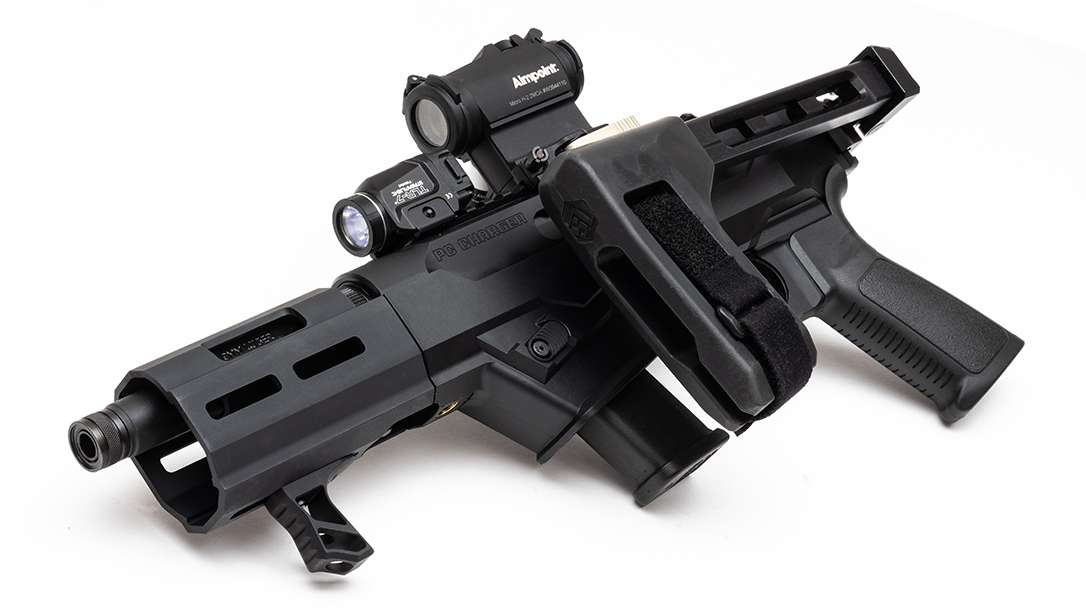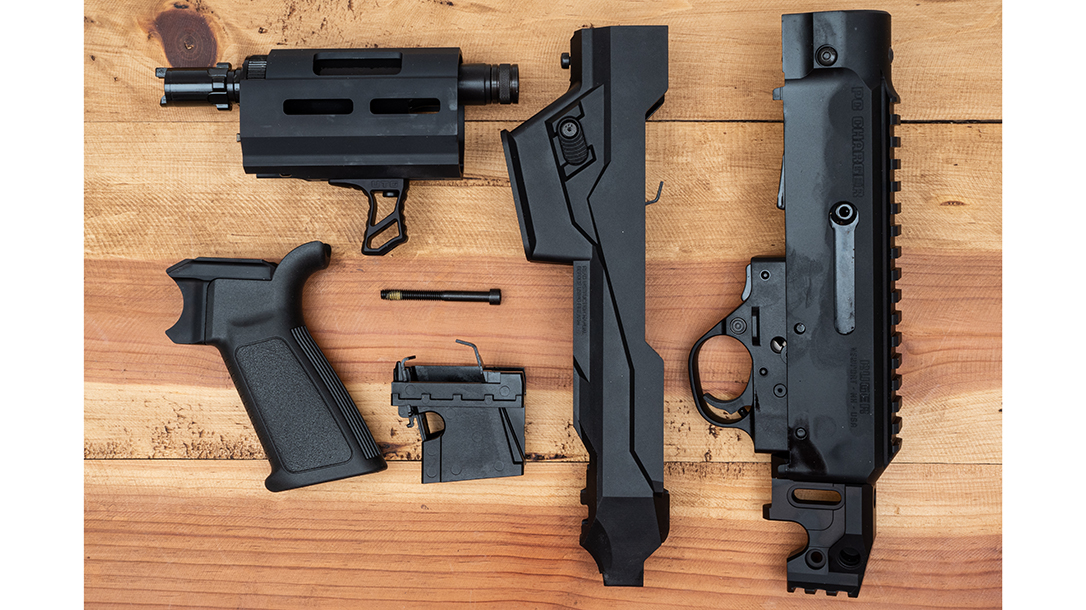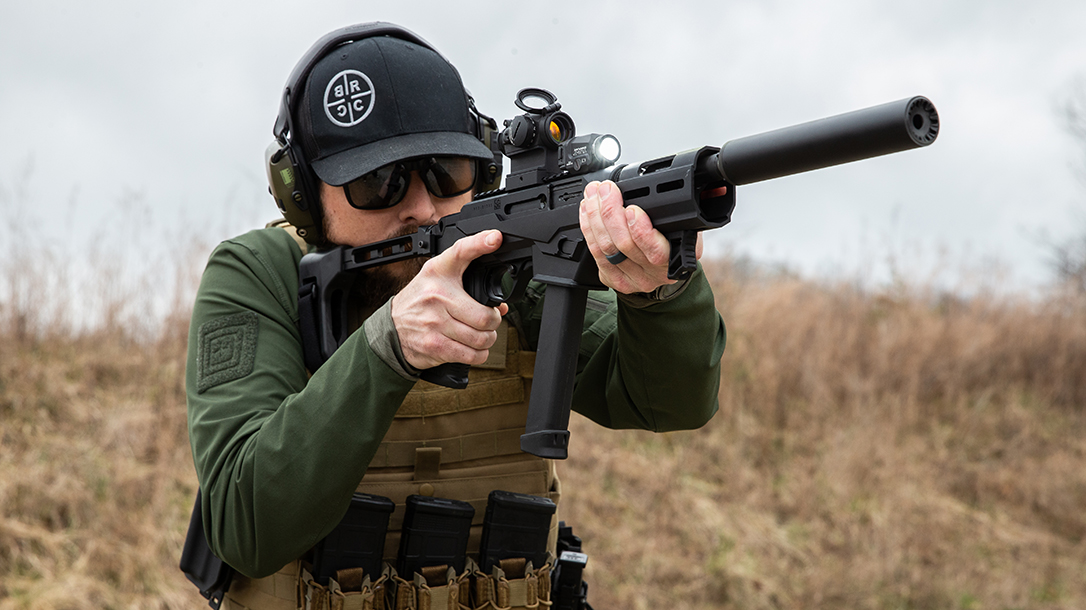The Ruger PC Charger is interesting, and we are in interesting times. The financial markets are experiencing violent swings. The price of silver has just cratered. The FED is injecting trillions of dollars of new money into the financial system in just a single month. The coronavirus is slowly starting to paralyze every aspect of American life from movie theaters to restaurants and even our nation’s public schools. The worst part? I don’t think there’s a roll of toilet paper to be found in the whole state of Kentucky.
Ruger PC Charger Details
While I don’t think this current state of affairs is the end of days, it doesn’t hurt to take steps to beef up your personal security measures just to be on the safe side. Fittingly enough, Ruger has just made a timely announcement of a new, low-profile PDW system that straddles the gap between a concealed carry pistol and a full-blown rifle or carbine. That new system is called the PC Charger.
Advertisement — Continue Reading Below
Charging Forward
Building on the success of the company’s extremely popular PC Carbine, particularly the recent chassis model, the PC Charger is, instead, a large-format pistol chambered in 9mm. Like the PCC, it has interchangeable magazine well systems for both Ruger and Glock pistol magazines. In fact, it shares a lot of the PCC’s DNA with the ability to separate the barrel and forend from the receiver via the quick takedown release. It also features the dead-blow tungsten weight to help reduce bolt travel and minimize recoil, and it includes a reversible bolt charging handle and a reversible magazine release as well. And yes, the 6.5-inch barrel is threaded (1/2 x 28) for a suppressor or other muzzle device. What can I say? It’s ready to rock and roll right out of the box.
Quite luckily, I was sent a review unit before the announcement, and I have to say that it’s been a little while since I’ve gotten this excited about a firearm. My excitement has to do with all the little touches that Ruger threw into the mix and the potential for what the PC Charger could be with a little imagination. For example, the glass-filled polymer chassis system allows the user to switch out the grip with any other standard AR grip of their choice. The forend includes M-LOK attachment points along with a factory-installed hand stop to protect the shooter. The pièce de résistance is the short Picatinny rail at the end of the PC Charger’s receiver; it allows the shooter to install a stabilizing brace or other accessories.
Charging to the Defense
Advertisement — Continue Reading Below
Alarmed by the hordes of frenzied, toilet-paper-seeking maniacs roving the streets and supermarket aisles, I seized on the PC Charger’s potential by dressing it out for personal defensive applications. The folks at SB Tactical sent over their excellent FS1913 folding brace. It attaches via the Picatinny rail at the rear of the Charger’s receiver. They sent the “A” version, which sports the aluminum strut versus a polymer one. The “A” model has a 9.25-inch length and weighs in at 13 ounces, 3 ounces more than the polymer model. It also runs $50 more than the polymer model, which has an MSRP of $199. But it’s worth the extra premium for both the looks, clean machining and the excellent build quality.
To keep the FS13 brace company on the PC Charger, I also mounted an Aimpoint Micro H1 red-dot optic on the integrated Picatinny top rail. The H1 turned out to be the perfect companion for such a low-profile package. Also, with its extra-long battery life, its always-on feature ensures that its ready to roll when you are. The last accessory was a Streamlight TLR-7 weapon light. I have several of these units. They’re rugged, easy to attach and offer an excellent output of 500 lumens. That output is great for lighting up a close-in area like a large room or hallway without too much light splashback that could affect the shooter’s vision.
Packable Power
With those accessories attached and with a standard 15- or 17-round magazine in the magwell, the PC Charger is a very sleek and compact package. It can be easily stowed into a medium-sized pack for discreet carry. Of course, I had to take it that one extra step; I tried out the PC Charger with my SilencerCo Octane-9 suppressor as well.
Advertisement — Continue Reading Below
In its standard setup, the suppressor would normally make it difficult to carry such a rig discreetly. However, with the ability to separate the barrel and handguard from the receiver, along with the attached suppressor, the user can break the PC Charger down into two pieces that can be slipped into a pack side by side. Problem solved!
Storming the Range
Of course, the “cool factor” matters not if the PC Charger didn’t hold up at the range where it counts. There was no problem there either. The first thing I noticed when I started popping steel plates was the very nice trigger pull. The PC Charger makes use of 10/22 trigger components. They made the trigger pull a crisp and light 3.4 pounds on average, according to my Lyman digital trigger gauge. The reset was not overly positive but it provided a tactile response along with a slightly audible click.
Advertisement — Continue Reading Below
While running several brands and weights of ammunition from Federal, SIG Sauer, Hornady and Black Hills, we encountered no issues with the PC Charger’s reliability. It didn’t matter if it was ball ammo or hollow points or whether we were running the suppressor or not, the blowback operating system ran everything without fail. With a short lead time for the announcement, we only got a few hundred rounds through the PC Charger so far. However, everything seems to be ticking all the boxes as expected.
The PC Charger is fitted with a heavy-contour, cold-hammer-forged barrel that should provide long life and excellent accuracy. We had too much fun shooting drills and popping steel that we didn’t sit down to shoot groups with it yet. But the PC Charger delivered the goods while we were shooting 6- and 8-inch plates at a fast pace. Certainly the Aimpoint H1 helped in that regard, but the PC Charger delivered the payload on point. I have no question as to its ability to deliver surgical precision when pressed into action.
Tremendous Value
Sure, there were a couple of minor things that I didn’t like if I had to be nitpicky about it. I don’t care for the cross-bolt safety too much, but it is what it is. Also, the magazine release is a little out of the way, up front on the magazine well. But that’s just simply the result of designing for standard pistol magazines and how they are released. But when factoring in the MSRP of just $799, the end user gets a tremendous amount of value in comparison to similar products on the market.
Advertisement — Continue Reading Below
That low price leaves a few extra bills in the wallet to let the shooter accessorize the PC Charger just about any way they like without having to feel guilty about the purchase. But aside from just a great value, the PC Charger is indeed a terrific, civilian PDW platform from what I’ve experienced so far.
It’s reliable, accurate, somewhat modular, and it just has a robust and quality feel with how it’s put together. It’s a perfect piece of stop-gap kit that you can keep in your car or pack that still falls under the “pistol” umbrella for concealed carry permit holders. In fact, this PC Charger left me so impressed that I’m sending a check to Ruger to make it mine. I can’t give a better endorsement than that. For more information, visit ruger.com.
Ruger PC Charger Pistol Specs
- Caliber: 9mm
- Barrel: 6.5 inches (Threaded ½ x 28)
- Overall Length: 16.5 inches
- Weight: 5.2 pounds
- Height: 5.6 inches
- Grip: Glass-Filled Nylon (A2 Style)
- Sights: NA/Picatinny Rail
- Action: Semi-Automatic
- Finish: Type III Anodized (Receiver)
- Capacity: 15/17/30
- MSRP: $799

























